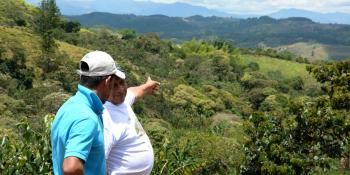Climate extremes impact on regional food security

A workshop held in December last year explored future climate projections for South Asia and East Africa's food and water security while discussing ways farmers are coping with climate variability in the two regions.
Extreme weather events, such as droughts and floods, cause enormous damage to food production all over the world and especially so in South Asia and East Africa. Climate projections suggest that more frequent and severe weather extremes are expected in the future under climate change.
Enhancing farmers’ coping capacity and improving agricultural and water policies will increase the resilience of rural communities towards both today’s and future climate extreme events.
On December 6 last year IFPRI hosted a workshop in Washington, DC to present preliminary research results from the CCAFS-supported project “Investigating the Impact of Climate Extremes on Future Water and Food Security” and to get feedback from senior researchers and policymakers working on issues related to climate extreme events from India and East Africa.
Several presentations focused on the severity and frequency of drought in South Asia, using statistical and biophysical models to identify vulnerable areas and prioritize drought mitigation measures. Results for Pakistan show that droughts exhibit cyclical behavior in which periods of intensive droughts, covering key agricultural areas of the country, appears to occur approximately every 16 years, followed by multi-year wet periods.
Furthermore, climate change may cause considerable declines in the yields of key staple crops, such as wheat, maize and rice, due to a shortening of the growing season under a warmer climate. This will have negative implications for food production and food security.
However, a dramatic increase in agricultural research, leading to productivity improvements; and improved irrigation efficiency, through the expansion of advanced irrigation technologies and sound management, can potentially achieve the best outcomes for Pakistan under climate change.
The presentations also highlighted significant challenges for India with more frequent and severe extreme events. One study under this project conducted by collaborator from the University of Illinois at Urbana-Champaign examined changing trend of climate variables and crop yields and their relationships, showing that increasing temperature during wheat growing months hurts crop yield more significantly than changes in rainfall.
Another study under this project analyzed the processes and consequences of serious groundwater depletion in northwestern India due to expansion of groundwater irrigation for water-thirsty crops such as rice and wheat.

India is suffering from increasing floods and droughts, affecting smallholder farmers all over the region. Photo: Madhavi
For northeast India, a study looked into crop planting and irrigation strategies for coping with delayed Monsoon in the State of Bihar, where land fragmentation and high production costs prevent small farmers from taking effective actions to adapt, using a hydro-economic modeling approach. The design for a regional study focusing on consequences of “mega-drought” in the Indo-Gangetic Plains also generated considerable interests among the participants, and useful comments were obtained.
Presentations on East Africa focused on drought impacts on crop production in Kenya and farmers’ perceptions of and responses to droughts and climate change in Ethiopia. The results show that droughts are becoming more frequent and persistent in Kenya, posing a serious threat to agricultural production.
In particular, water stress is severely hindering the production of rainfed maize, a key staple crop. Irrigation is a promising strategy to increase yields of maize under drought conditions. However, diminishing marginal returns to irrigation suggest that careful cost-benefit and risk analysis will be needed before making any major irrigation investment.

Frequent droughts and variable rainy seasons make it hard to grow rainfed maize in east africa. photo: C.schubert (CCAFS)
Results obtained from the second round survey of households in the Nile Basin of Ethiopia show that climate shocks, particularly droughts and hailstorms, continue to have a negative impact on the livelihoods of poor rural farmers, with major effects on crop production, income, and consumption.
The main strategies for coping with extreme events have not changed much over time and include selling livestock, consuming less, seeking off farm employment, migration, and borrowing from relatives. However, strategies used to adapt to the impacts of climate change have changed with more households reporting that they are planting trees, increasing fertilizer applications, and changing crop types in addition to implementing soil water conservancy measures.
Besides providing useful comments to results from this project, our invited participants from India and East Africa also presented their research, opinions, and policy insights. For example, Dr. Alok K. Sikka, Deputy Director General of the Indian Council of Agricultural Research, gave a presentation on “Programs and Policies for Water and Food Security in Rainfed Areas of India,” and Mr. David Ndiritu Muchemi, Assistant Director of Meteorological Services at Kenya Meteorological Department, presented “Climate extremes over Kenya in the last 100 years.”
Learn more about this project: Investigating the Impact of Climate Extremes on Future Water and Food Security
Climate projections for East Africa: Based on what we know, can Kenya plan its climate future?
Climate projections for West Africa: New report reveals how climate change will hit West Africa
Elizabeth Basauri Bryan works at International Food Policy Research Institute (IFPRI).



